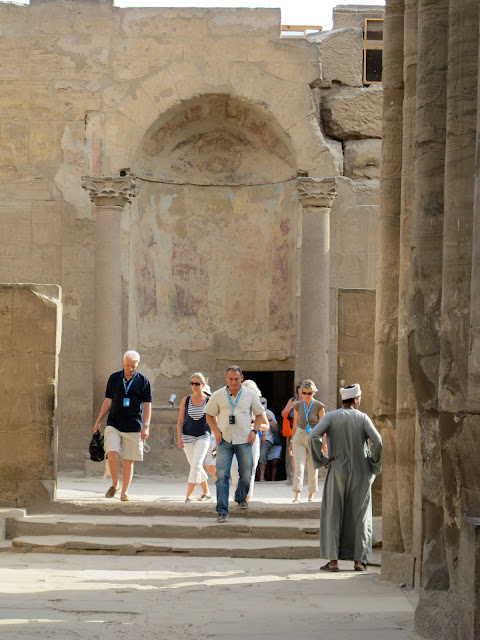LUXOR - April 27

It's hard to know what to say about our visit to the temples and tombs in Luxor. First of all, 9 hours south of Cairo, it was really hot. We hired a tour guide who brought us to all of the sites on the East Bank of the Nile on our first day in Luxor, and we visited the West Bank with him on our second day.
The East Bank of Luxor is the living city-- it contained the temples of Karnak and Luxor with an Avenue of Sphinxes, a few km long, connecting them. The Egyptian government is currently undertaking a project to clear the homes and stores where the avenue once ran and restore it for tourists and make the entire city of Luxor "an open air museum." The city itself was quite poor and relied on tourism for 85% of its economy (with the balance for sugarcane farming and processing). It was really striking to walk a block from our "four star" hotel right into the slums.

Poverty aside, Luxor is a remarkable city. The temples were enormous, and extremely well preserved considering that they were 4000 years old. Many of the reliefs and hieroglyphics (no one seems to use that word here, though) still boasted their original vibrant colors and told the stories of the pharaohs and gods to whom they were dedicated. Our guide brought the stories to life for us, and gave us the condensed version of 3000 years of pharaonic Egyptian history.

The West Bank of the Nile contained the tombs of the pharaohs and nobles. Much as the sun rises in the east and sets in the west, the pharaohs lived on the East Bank of the Nile and waited for their afterlife on the West Bank. In the Valley of the Kings, the pharaohs of the New Kingdom period built their tombs not in pyramids but into the very rock of the mountains, so as to discourage robbers (the pyramids had already been robbed 1000 years before). Photographs were not allowed in these tombs, but the paintings on the insides were spectacular and the colors rich and vibrant.
We also visited the Valley of the Nobles and Valley of the Workmen, each containing tombs of Egyptians of lesser stature, but of no less striking beauty to us. The tomb that we saw at the Valley of the Nobles was particularly interesting because it depicted the activities of daily living, and contained many unfinished paintings, so we were able to see the process of the artisans.
The last site we visited on the West Bank was Queen Hatshepsut- a three story temple she built (see the first photo above). She ruled as a king, wore a false beard, and insisted that male pronouns be used when addressing her and speaking of her. In this way, she was able to circumvent the law that only men could rule as pharaohs. Obviously, Jillian liked this site.
With no time to spare, we were back on an overnight train bound for Cairo. With the conductor waking us at 3:30am for breakfast, we were pooped when we got back to the city, and flopped right down on the couches of our hostel for a nap as soon as we arrived.
Lots of love,
Jillian + Ari


No comments:
Post a Comment